How to Use primax Tinnitus Therapy Options
Vera Wolf, Dipl.-Ing. (FH)
1. Introduction
Tinnitus affects a large percentage of patients with hearing loss, and various therapy protocols are used by audiologists and hearing care professionals (HCP) more and more to address these patient concerns. Although there are many manifestations of tinnitus one common type of tinnitus is called tonal tinnitus, meaning that the tinnitus percept is comparable to the sound of one or more pure tones. For this type of subjective tinnitus, research in the past few years has shown that introducing a notch filter in acoustic stimuli which corresponds to the subjective tinnitus frequency can be a very successful therapeutic method [1][2].
With the introduction of the Tinnitus Notch Therapy [3] for primax, a very narrow notch filter is applied to the frequency response of the hearing instruments. It is recommended for patients to utilize Tinnitus Notch Therapy as long as they are able during the day for best results. While some patients have shown improvement in as little as three weeks, it is more common to see significant benefit after three months, or even longer.
Tinnitus Notch Therapy in primax is quick and easy to fit. Alternatively, a variety of therapy signals are also available in primax hearing instruments [4] that can be used with other tinnitus sound therapy strategies [5].
2. Fitting and Fine Tuning Tinnitus Notch Therapy
2.1 Who is a candidate for Tinnitus Notch Therapy?
Tinnitus Notch Therapy is in principle suitable for use with all patients experiencing subjective, tonal tinnitus. Tonal tinnitus means all types of pure-tone like, whistling, ringing or humming sounds which originate internally and are only audible to the patient. Recent research on Tinnitus Notch Therapy has shown that this approach appears to be especially effective for patients suffering from severe tinnitus [6].
2.2 How to fit Tinnitus Notch Therapy – step-by-step
To implement Tinnitus Notch Therapy for patients using primax hearing instruments, first perform a First Fit using the Connexx fitting software, and fine tune the settings as you would for any patient. Fine tuning should be completed, including programming any additional listening programs if required, prior to setting up Tinnitus Notch Therapy. Next, open the Tinnitus tab on the left-hand navigation bar, and select Notch Therapy.
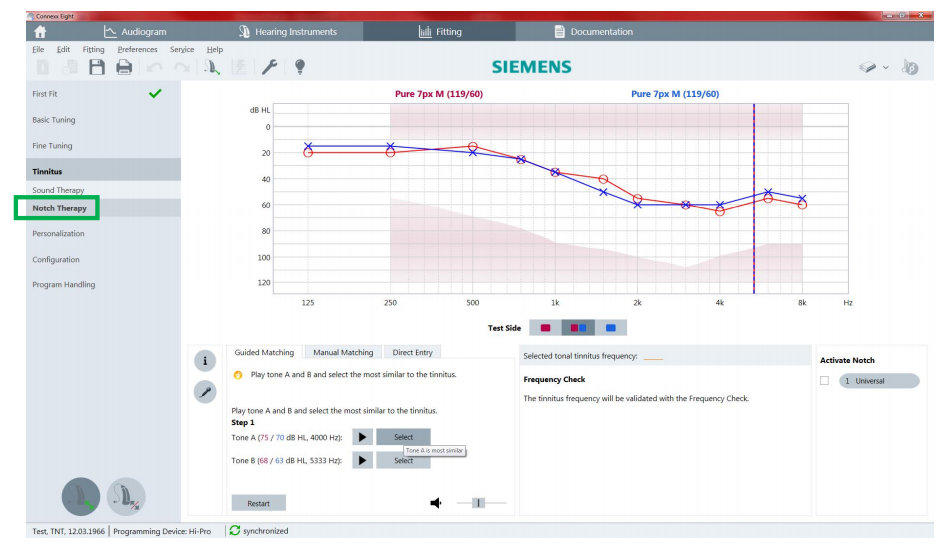
The first and most important step to fitting Tinnitus Notch Therapy is the determination of the tinnitus frequency, also referred to as “pitch matching”. Since this measured frequency determines the proper placement of the notch filter, this step is critical in the success of Tinnitus Notch Therapy. We recommend to follow the Guided Matching approach in general for highest efficiency.
In Connexx, pitch matching can be carried out in two ways:
1.Guided Matching: The tinnitus frequency is determined using a series of adaptive simple A-B comparisons [7]. The HCP plays Tone A and Tone B by pressing the corresponding button, and the patient determines which of the two sounds are more similar, i.e. closer in pitch to the perceived tinnitus. The HCP can then select the corresponding tone decide via Select.
Note that for both Guided Matching and Manual Matching procedures, the tones are presented to both ears by default in bilateral fittings. The HCP may also choose to present tones to one ear only. In cases where the tinnitus is unilateral, contralateral tone presentation is recommended. In other words, if the tinnitus is heard only in the left ear, pitch matching should be carried by presenting tones to right ear.

The tone is presented as soon as the button is pushed and terminates when the button is released.
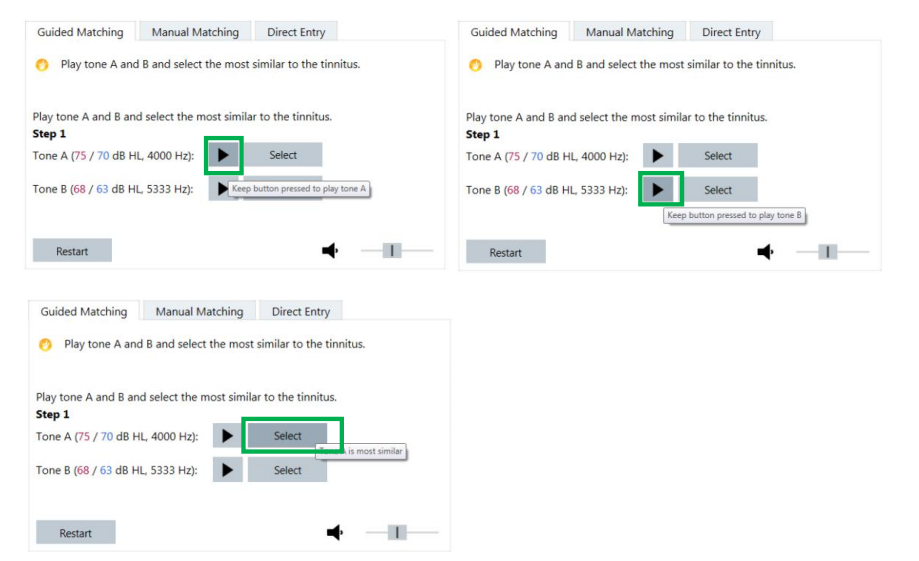
The underlying algorithm will automatically calculate the next appropriate presentation tones based on the selection. Test tones are played at an initial loudness of 5 dB SL, based on the patient’s audiogram. In case the presentation loudness is not suitable, it can be adjusted using the slider on the lower right.
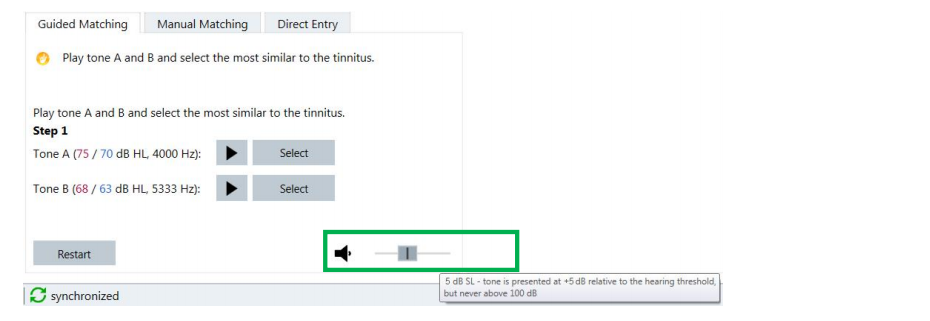
The procedure will automatically terminate as soon as the required accuracy has been reached, depending on the feedback given. The determined frequency is then directly used to activate the tinnitus notch for the desired listening programs.

This procedure may be repeated at any time via Restart. Note that all current results will then be discarded, and the procedure starts anew.
Further information on matching the patients’ tinnitus frequency can be found in the Tinnitus Matching Instructions accessible via i on the left side of the page:
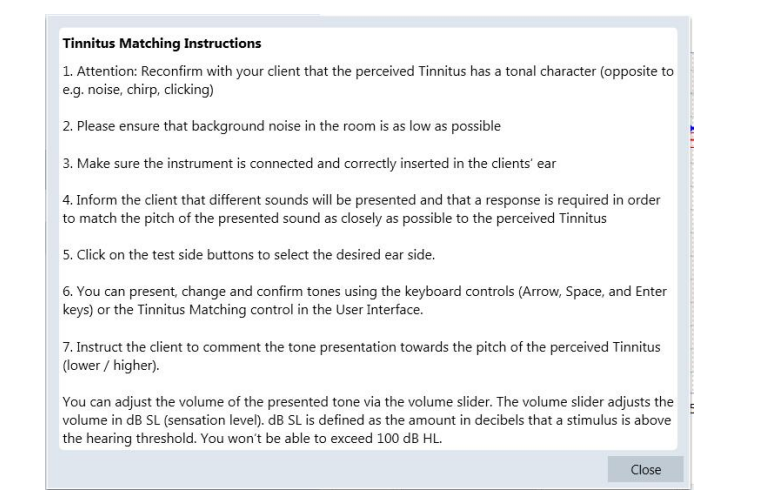 2. Manual Matching: Alternatively, the tinnitus frequency can be determined also manually, using a user control similar to the Connexx InSituGram function
2. Manual Matching: Alternatively, the tinnitus frequency can be determined also manually, using a user control similar to the Connexx InSituGram function
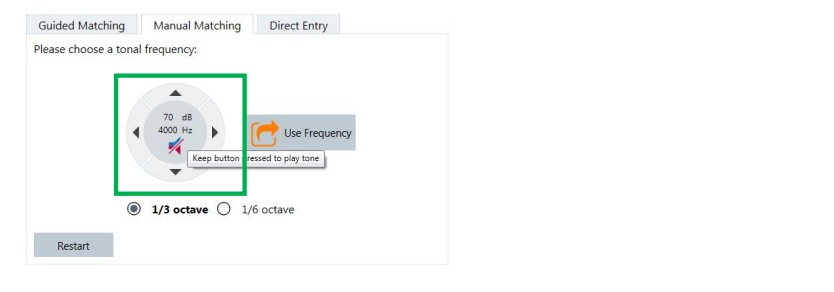
or via keyboard controls, as described in the Tinnitus Matching Instructions accessible via i.
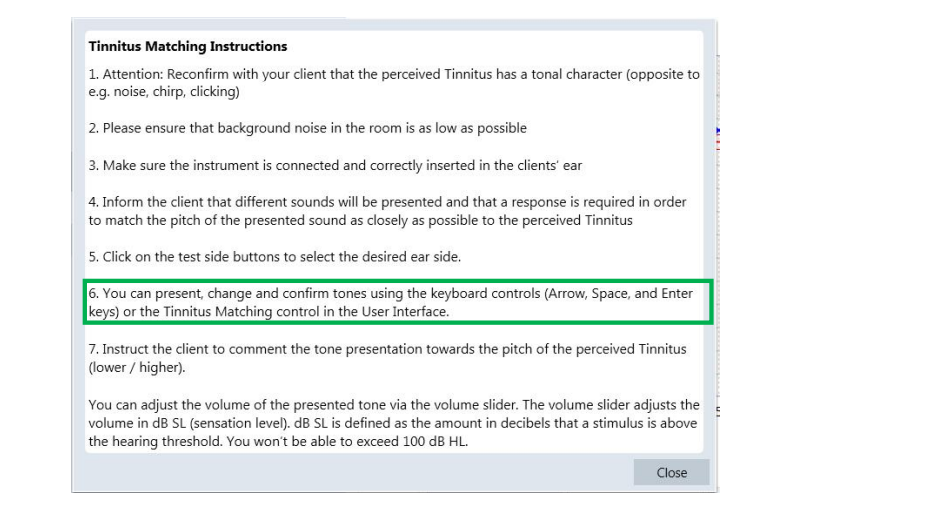
During Manual Matching, instruct the patient to direct the presentation of the tones (e.g. by saying “lower” or “higher”) in order to match the perceived tinnitus. The step size for neighboring frequencies can be selected between 1/3 and 1/6 octaves.
Direct Entry: The professional may also directly select a tinnitus frequency from a list and confirm it via Use Frequency. This can be especially helpful if the tinnitus frequency has already been determined previously.
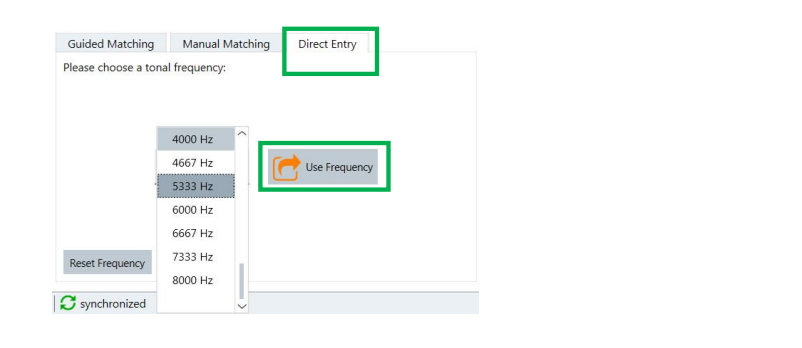
3. Frequency Check: This procedure is highly recommended as a final step during tinnitus pitch matching. It can correct a misjudgment of pitch by octaves, also referred to as octave confusion [8], which may often occur with untrained patients. The Frequency Check is very similar to the Matching procedure. Play Tone A, Tone B, and additionally Tone C, if available. Ask the patient to compare these three, and then choose via Select the tone most similar, i.e. closest in pitch, to the perceived tinnitus.
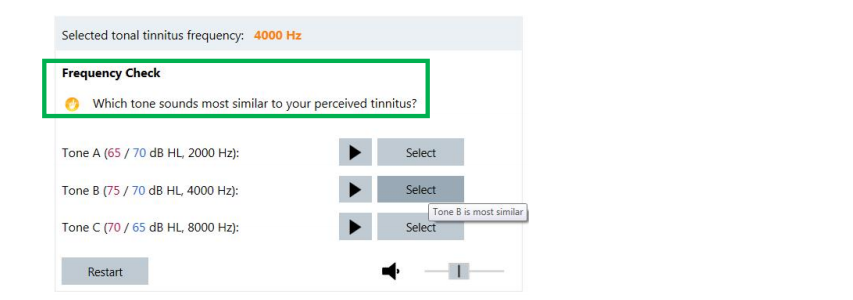
This procedure consists of only one step and the selected tone is then confirmed as the final tinnitus frequency. The loudness of the presentation tones can be adjusted using the slider on the lower right. Note that the option for Tone C may be grayed out if the final octave step of the selected frequency is too high and lies beyond the measurable range.
Of course if necessary, the test can be repeated at any time via Restart, in which case the previous results are discarded.
4. Activate Notch: As soon as the tinnitus frequency has been confirmed, Tinnitus Notch Therapy should be activated in all compatible listening programs via the checkbox for maximum effectiveness.

With primax hearing instruments, Tinnitus Notch Therapy is not available for programs or fittings using
- Telecoil / Induction Loop
- Direct Audio Input
- CROS / BiCROS
Once the tinnitus notch has been applied in the program, it is readily visible to the HCP in the regular curve display as indicated with a yellow shaded region.
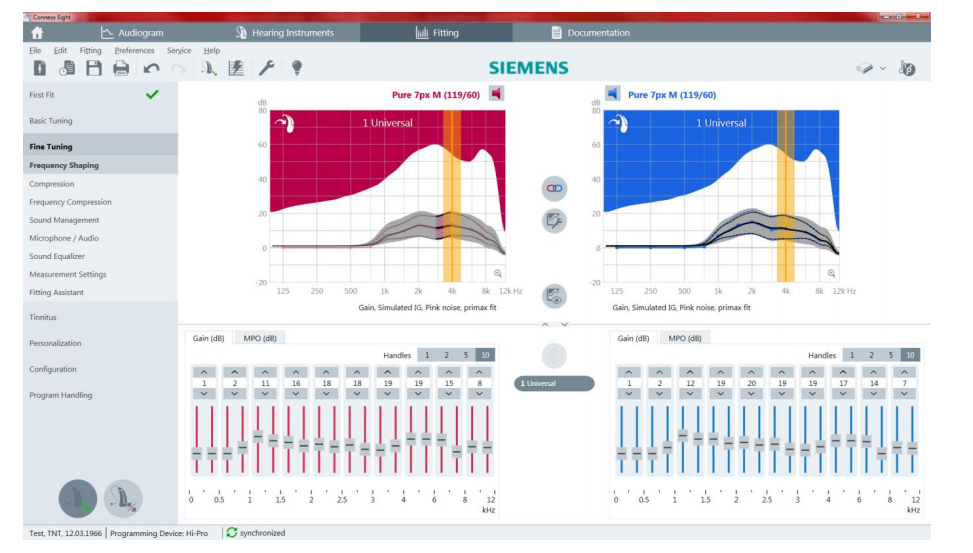
Tinnitus Notch Therapy is different from the Tinnitus Sound Therapy program, which can be activated under program handling. The Tinnitus Sound Therapy program which applies an additional tinnitus therapy signal should be selected when implementing conventional tinnitus sound therapies (for an overview, see [4]). With the new Tinnitus Notch Therapy approach, a default program selection is not practical since the tinnitus frequency needs to be specifically determined before program activation.
For primax hearing instruments, the Tinnitus Notch Therapy and conventional tinnitus sound therapy cannot be activated in the same program, but only in separate listening programs.
2.3 Time-saving tips and strategies
- Before fitting Tinnitus Notch Therapy, it is recommended to conduct an individual First Fit to ensure an adequate amount of amplification, which is required for an effective application of the feature.
- Gain should exceed 10dB on the lower frequency side of the notch for the therapy to provide positive effects.
- For Tinnitus Notch Therapy, it is not required to match the loudness of the test tone to the tinnitus percept. The only requirement is to match the pitch of the test tone as closely as possible to the tinnitus percept, in order to position the notch at the correct frequency.
- The recently-introduced First Fit feature Mimic fit can transfer settings of an existing hearing instrument fitting to another with different receiver types, families, and even platforms. When using this feature similar to the “Recalculate Fit” option during first fit, tinnitus settings in the initial device are automatically taken over to the new “target” hearing instrument, regardless of whether Tinnitus Notch Therapy or conventional sound therapy approaches have been followed.
2.4 Considerations on real ear measurements and verification
To verify the hearing instrument fitting after applying the tinnitus notch, or directly measure the effect of the notch on sound transmission via the hearing instrument, it is recommended to follow established protocols, e.g. [9] [10] for real-ear measurements. Since Tinnitus Notch Therapy only takes away amplification within a ½-octave around the tinnitus frequency, the filter effect can be seen directly in the measured frequency response. The position and depth of the notch can be seen most effectively by using a pure-tone sweep as test signal.
In general, when using non-speech signals for measuring the hearing instruments, the “test settings” function must be activated in Connexx in order to ensure that the selected test signal does not affect the measurement result. Otherwise, real ear measurements can be carried out as usual.
Note that since the applied notch is very narrow, speech intelligibility in daily life is not compromised.
2.5 Instructions for Tinnitus Notch Therapy fine tuning
2.5.1 How to fine tune
As Tinnitus Notch Therapy depends highly on the correct determination of the tinnitus frequency, it is not recommended to conduct any manual fine tuning of the therapeutic notch itself beyond establishing the accurate tinnitus frequency. Of course the audiologist or HCP may modify in which programs the therapy is activated. Hearing instruments with Tinnitus Notch Therapy activated should be worn for at least 8 hours a day, at least 3 months before evaluating its effectiveness and benefit. This especially applies to patients with mild hearing losses and therefore fittings with low insertion gain. Since it is important to ensure sufficient amplification on the spectral edges of the notch, for these patients, it may be necessary to increase high frequency gain slightly, particularly on the lower frequency side of the notch, in order to improve its therapeutic effectiveness.
2.5.2 How to use other sound therapy approaches, and when to try them
If the patient does not suffer from tonal tinnitus, or if Tinnitus Notch Therapy has not proven effective after at least 6 months of use, conventional tinnitus sound therapy strategies using static or modulated broadband acoustic signals [4] are good alternatives for consideration.
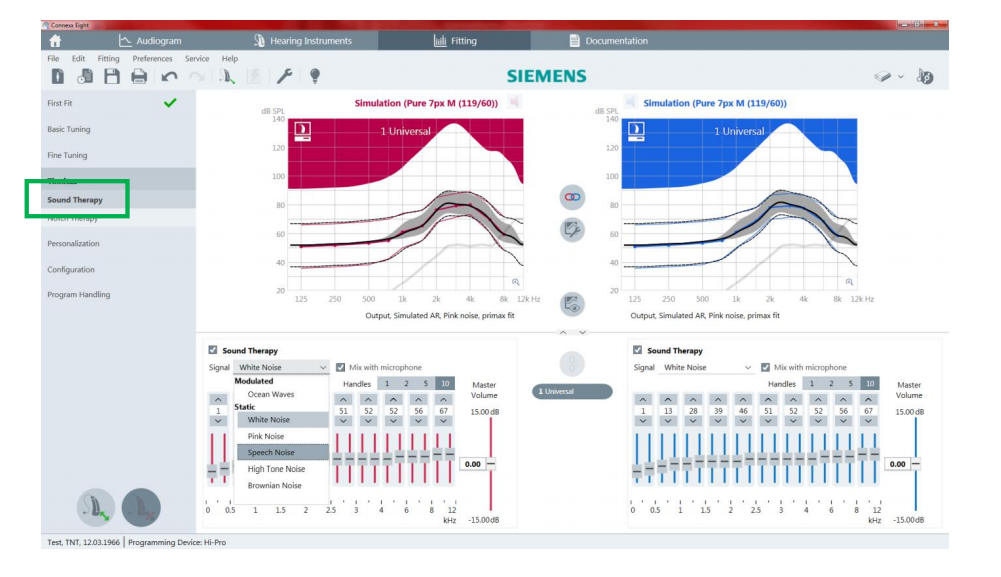
Please note that with primax, only one of the two tinnitus therapy features can be selected in a program at a time.
2.6 How do Signia tinnitus solutions fit into the treatment protocols?
With various therapy approaches such as TRT or Progressive Tinnitus Management (PTM) [11], tinnitus severity may be assessed via standardized questionnaires such as Tinnitus Functional Index [12], Tinnitus Hearing Survey [13], or Self-Efficacy for Managing Reactions to Tinnitus [14].
Once the individual tinnitus frequency as been determined, the notch activated in the listening programs may help to reduce the perception of tonal tinnitus. This may be especially helpful as acknowledged protocols for managing hearing loss recommend combination instruments when patients also suffer from hearing loss.
Signia primax hearing instruments, which offer comprehensive solutions for hearing loss and tinnitus, provide the hearing care professional with the required tools for successful and efficient tinnitus management and treatment of hearing loss.
3. Conclusion
Tinnitus Notch Therapy – the novel and unique alternative therapy approach to treat tonal tinnitus – is easy to fit with primax and Connexx. In addition, ample options for conventional treatment of tinnitus using different static and modulated broadband acoustic stimuli are also available. This comprehensive tinnitus treatment toolkit is a powerful asset for any hearing care professional working with tinnitus patients. It also fits particularly well within the VA’s Progressive Tinnitus Management Guideline. Tinnitus Notch Therapy can be incorporated into PTM as a tool to help veterans with tinnitus. The hearing care professional can choose among treatment options such as hearing aid amplification only, Tinnitus Notch Therapy, or Tinnitus Sound therapy.
4. Literature
[1] Pantev, C., Okamoto, H., & Teismann, H. (2012). Music-induced cortical plasticity and lateral inhibition in the human auditory cortex as foundations for tonal Tinnitus treatment. Frontiers in Systems Neuroscience, 6. DOI: 10.3389/fnsys.2012.00050.
[2] Strauss, D., Corona-Strauss, F., Seidler, H., Haab. L., & Hannemann, R. (2016), Notched environmental sounds: A new hearing aid-supported tinnitus treatment evaluated in 20 patients. Clinical Otolaryngology. DOI: 10.1111/coa.12575.
[3] Powers, L., & Munhóes dos Santos, G. (2016). Notch Therapy: a new approach to tinnitus treatment. In submission.
[4] Powers L, Munhóes dos Santos G. (2015). Acoustic Therapy for the Treatment of Tinnitus: A Primer. Hearing Review, 22(6). 22.
[5] Powers, L., & Ramirez, T. (2014). Clinical management of tinnitus. AudiologyOnline, Article 12558. Retrieved from: http://www.audiologyonline.com/articles/clinical-management-of-tinnitus-12558
[6] Haab, L., Lehser, C., Corona-Strauss, F., Bernarding, C., Seidler, H., Strauss, D., Hannemann, R. (2016). Six-Month Evaluation of a Hearing Aid Supported Tinnitus Treatment Using Notched Environmental Sounds. In submission.
[7] Henry, J. Flick, C., Gilbert, A., Ellingson, R., Fausti, S. (2001). Comparison of two computerautomated procedures for Tinnitus pitch matching. Journal of Rehabilitation Research and Development, 38( 5). 557–566.
[8] Henry, J. & Meikle, M. (2000). Psychoacoustic measures of tinnitus. Journal of the American Academy of Audiology, 11. 138-155.
[9] Dillon, H. (2012). Hearing Aids (2nd ed.). New York: Thieme.
[10] Mueller, G., Bentler, R., & Ricketts, T. (2014). Modern Hearing Aids: Pre-Fitting Testing and Selection Considerations. San Diego: Plural.
[11] Progressive Tinnitus Management (PTM) – Level 2. Veterans’ Administration National Center for Rehabilitative Auditory Research (NCRAR). http://www.ncrar.research.va.gov/Education/Documents/TinnitusDocuments/05_HenryPTMHB_39-50.pdf
[12] Tinnitus Functional Index. Veterans’ Administration National Center for Rehabilitative Auditory Research (NCRAR). http://www.ncrar.research.va.gov/Education/Documents/TinnitusDocuments/TFI.pdf
[13] Tinnitus Hearing Survey. Veterans’ Administration National Center for Rehabilitative Auditory Research (NCRAR). http://www.ncrar.research.va.gov/Education/Documents/TinnitusDocuments/THS.pdf
[14] Self-Efficacy for Managing Reactions to Tinnitus (SMRT). Veterans’ Administration National Center for Rehabilitative Auditory Research (NCRAR). http://www.ncrar.research.va.gov/Education/Documents/TinnitusDocuments/SMRT.pdf
